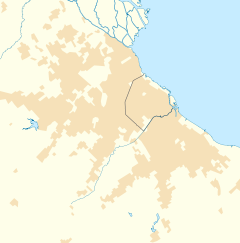
The Argentine Confederation was the last predecessor state of modern Argentina; its name is still one of the official names of the country according to the Argentine Constitution, Article 35. It was the name of the country from 1831 to 1852, when the provinces were organized as a confederation without a head of state. The governor of Buenos Aires Province managed foreign relations during this time. Under his rule, the Argentine Confederation resisted attacks by Brazil, Bolivia, Uruguay, France and the United Kingdom, as well as other Argentine factions during the Argentine Civil Wars.
Lanús is the capital of Lanús Partido, Buenos Aires Province in Argentina. It lies just south of the capital city Buenos Aires, in the Greater Buenos Aires metropolitan area. The city has a population of 212,152, and the Partido de Lanús has a total population of 453,500.
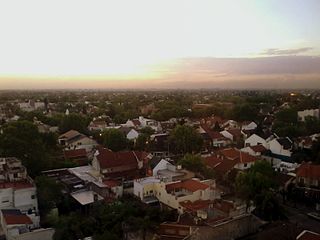
Lomas de Zamora is a city in the province of Buenos Aires, Argentina, located south of the City of Buenos Aires and within the metropolitan area of Greater Buenos Aires. It is the capital of Lomas de Zamora Partido and has a population of 111,897.

Banfield is a city in the district of Lomas de Zamora in Buenos Aires Province, Argentina, 14 km (9 mi) south of the city center of Buenos Aires. It forms part of the Greater Buenos Aires metro area.
El Palomar is a town in the urban agglomeration of Greater Buenos Aires in Argentina. It is located 20 km (12 mi) west of Buenos Aires.

La Matanza is a partido located in the urban agglomeration of Greater Buenos Aires, Buenos Aires Province, Argentina.

The Argentine National Historical Museum is located in Buenos Aires, Argentina, and is a museum dedicated to the history of Argentina, exhibiting objects relating to the May Revolution and the Argentine War of Independence.
Lomas, also called fog oases and mist oases, are areas of fog-watered vegetation in the coastal desert of Peru and northern Chile.
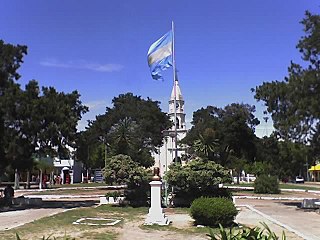
Merlo is the head city of the eponymous partido of Merlo and seat of the municipal government, located in the Greater Buenos Aires urban area of Buenos Aires Province, Argentina.

Llavallol is a district of Lomas de Zamora Partido in Buenos Aires Province, Argentina. It forms part of the Greater Buenos Aires urban conurbation.
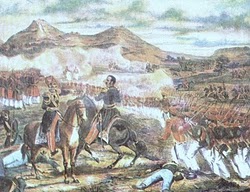
The Battle of Famaillá, was a Federal Party victory, under the command of former Uruguayan president Manuel Oribe, over the army of the Unitarian Party under general Juan Lavalle, during the Argentine Civil War.

María Amalia Lacroze de Fortabat was an Argentine executive and philanthropist.
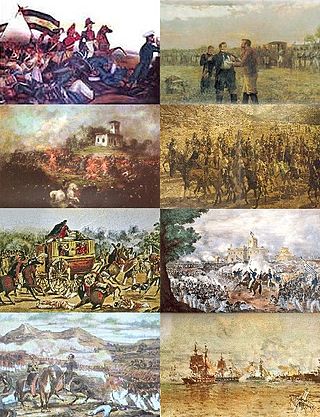
The Argentine Civil Wars were a series of civil conflicts of varying intensity that took place through the territories of Argentina from 1814 to 1853. Beginning concurrently with the Argentine War of Independence (1810–1818), the conflict prevented the formation of a stable governing body until the signing of the Argentine Constitution of 1853, followed by low-frequency skirmishes that ended with the Federalization of Buenos Aires. The period saw heavy intervention from the Brazilian Empire that fought against state and provinces in multiple wars. Breakaway nations, former territories of the viceroyalty, such as the Banda Oriental, Paraguay and the Upper Peru were involved to varying degrees. Foreign powers such as the British and French empires put heavy pressure on the fledgling nations at times of international war.

The Port of Buenos Aires is the principal maritime port in Argentina. Operated by the Administración General de Puertos, a state enterprise, it is the leading transshipment point for the foreign trade of Argentina.
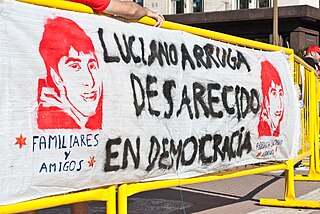
Luciano Arruga was an Argentine teenager who went missing on January 31, 2009, when he was intercepted by police in Buenos Aires Lomas del Mirador, Buenos Aires Province, Argentina. His remains were found on October 17, 2014.
The Battle of Márquez Bridge, fought on 26 April 1829, during the civil war between Unitarians and Federalists, resulting in a victory for the Federal Party forces of Juan Manuel de Rosas and the governor of Santa Fe Province, Estanislao López, over general Juan Lavalle, who had usurped the office of Governor of Buenos Aires Province.

The Buenos Aires Great Southern Railway (BAGS) was one of the Big Four broad gauge, 5 ft 6 in, British-owned companies that built and operated railway networks in Argentina. The company was founded by Edward Lumb in 1862 and the first general manager was Edward Banfield after whom the Buenos Aires suburban station of Banfield was named, when it opened in 1873. After president Juan Perón nationalised the Argentine railway network in 1948 it became part of the state-owned company Ferrocarril General Roca.

The State of Buenos Aires was a secessionist republic resulting from the overthrow of the Argentine Confederation government in the Province of Buenos Aires on September 11, 1852. The State of Buenos Aires was never recognized by the Confederation; it remained, however, independent under its own government and constitution. Buenos Aires rejoined the Argentine Confederation after the former's victory at the Battle of Pavón in 1861.

The Sociedad Sportiva Argentina was an Argentine multi-sports club sited in Buenos Aires. The headquarters were located in Florida street nº 183 while the stadium was sited in Palermo, next to Hipódromo Argentino. Originally established in 1899 under the name "Sociedad Hípica Argentina" for the practise of equestrian activities, the Sociedad Sportiva would held a large variety of sport events in several disciplines, such as football, athletics, auto racing, aviation, aerostatics, aeronautics, boxing, bicycle racing, motorcycle racing, polo, rugby union, trot, sulky races, show jumping, among others.

